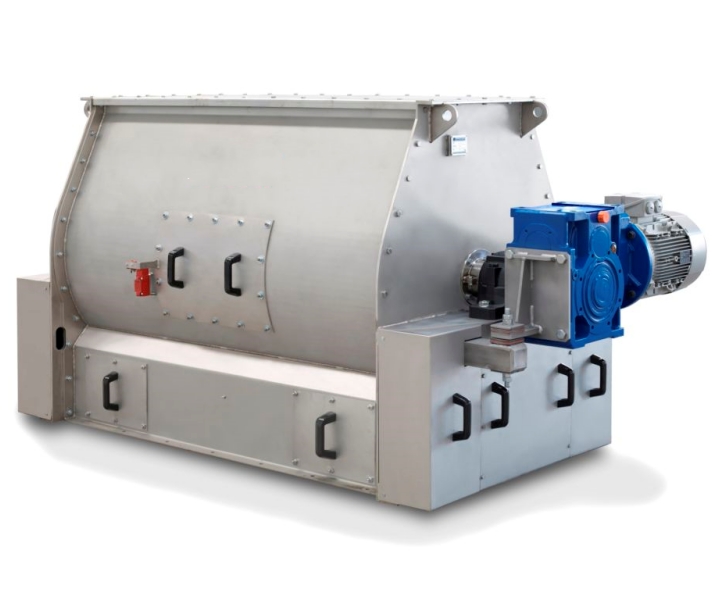
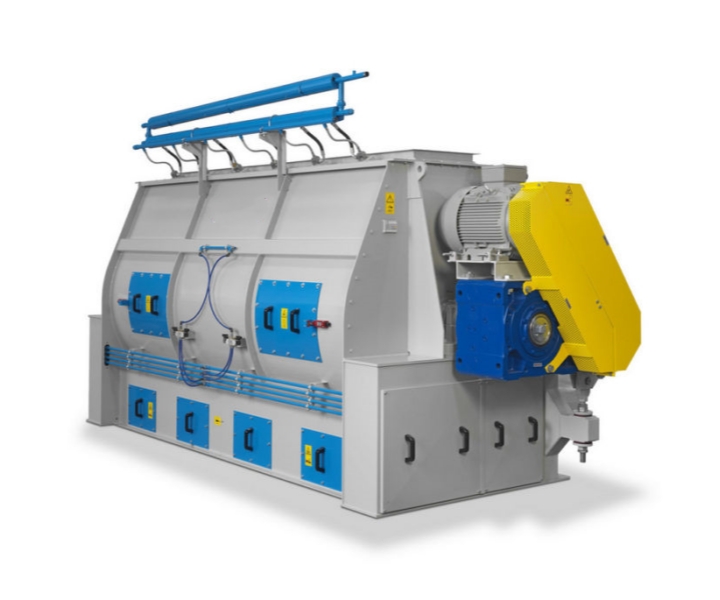
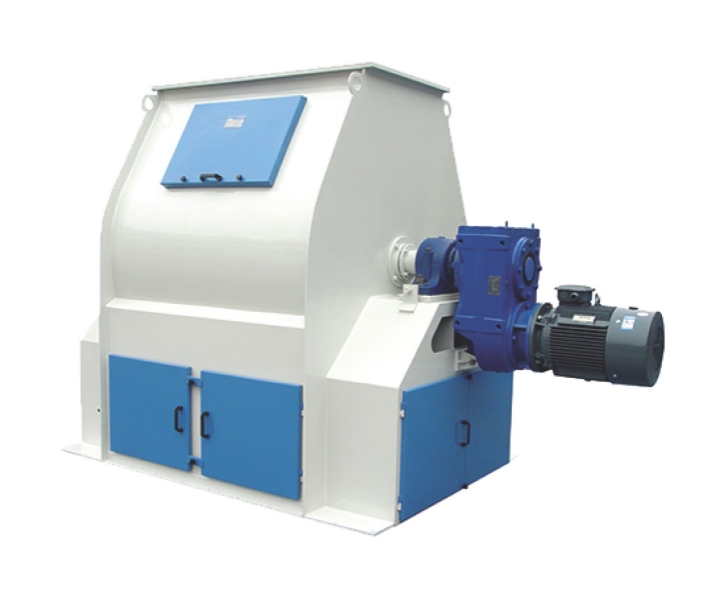

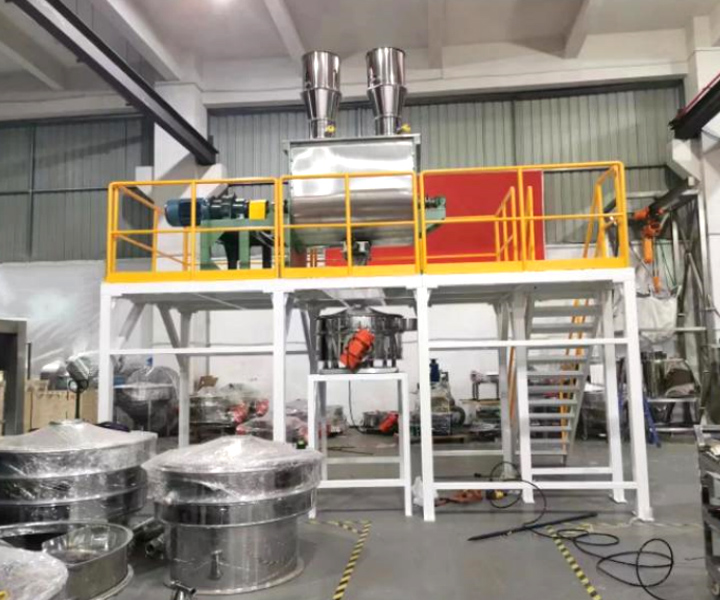





Uniform mixing of materials is achieved through the rotation of a single shaft and the action of internal mixing blades
![]()
![]()
Price:$1,099.00-$1,999.00/Set
Consult now and enjoy a 10% discount
Mixing time: 8-20min
Weight: 500kg-7500kg
One-time mixing: 100-6000kg
Voltage: 380 Volt
Mixing speed: 15-60r/min
Application: Various processing activities in the pharmaceutical, food, plastics, metals and minerals, nuclear energy, chemicals, pigments and coatings industries
Commitment: Free Shipping/5 Days Delivery/30-Day Returns/Support Customization
Single shaft horizontal mixer is a common mixing equipment, which consists of a horizontally placed shaft and agitator. During the mixing process, the materials are mixed along the direction of the axis through the rotation of the agitator. This type of mixer is generally suitable for larger-capacity mixing tasks and can handle a variety of powdery, granular or viscous materials. Single horizontal shaft mixer has the characteristics of simple structure, convenient operation and good mixing effect. It is widely used in building materials, chemical industry, metallurgy, pharmaceutical and other industries.

The working principle of the Single horizontal shaft mixer is to mix materials through the rotation of the shaft and agitator. After the materials are put into the mixer, they continue to interact and collide with other materials under the action of the mixer, thereby achieving a mixing effect. The shape and number of agitators can be designed according to different application requirements to ensure that materials can be fully mixed. Single horizontal shaft mixer usually has efficient and uniform mixing effect, which can meet various production process requirements and improve production efficiency and product quality.
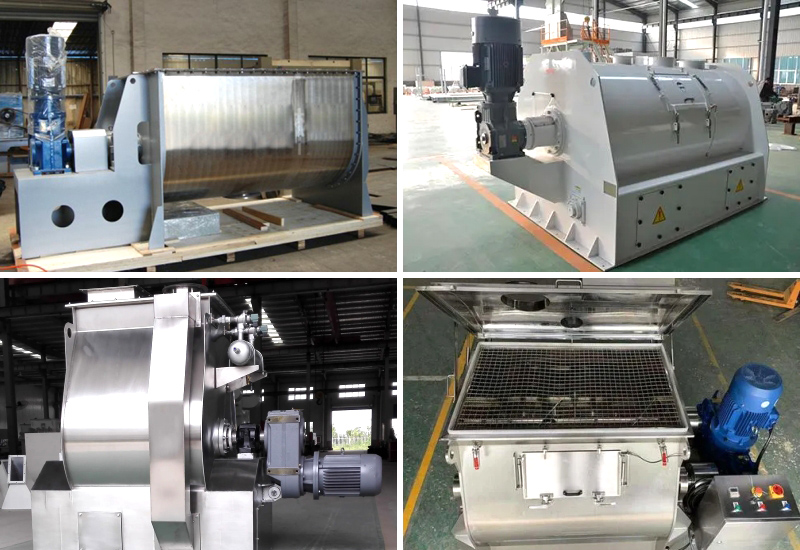
Single shaft horizontal mixers are widely used in building materials, chemical, metallurgy, pharmaceutical and other industries, mainly in the following areas:
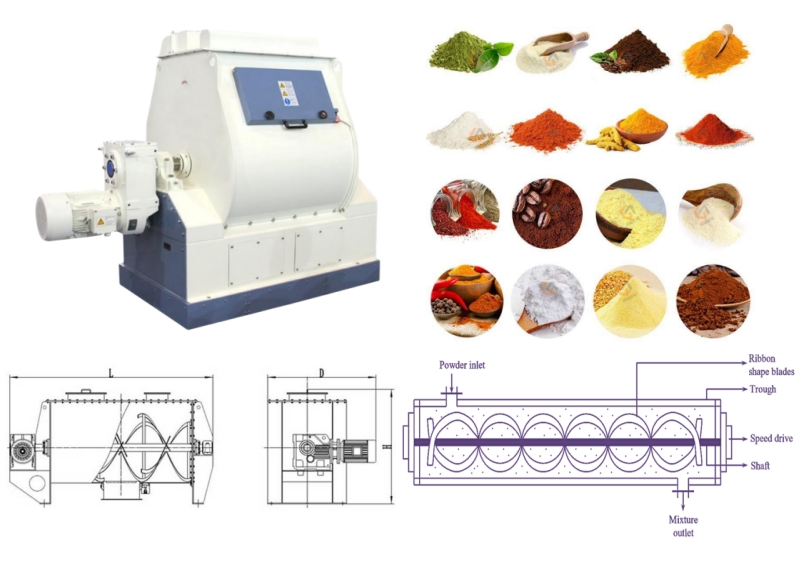
Mixing dry powder materials: used to mix dry sand, cement, gypsum, stone powder, etc. to prepare various types of mortar, tile adhesive, putty and other building materials.
Mixed granular materials:suitable for mixing granular materials, such as fertilizers, granular fillers, etc., for the production of pesticides, fertilizers, granular fillers and other products.
Mixing viscous materials: used to mix viscous materials, such as adhesives, glues, coatings, etc., and used to prepare chemical products such as adhesives and coatings.
Mixed chemical raw materials: Suitable for mixing chemical raw materials, such as polymer powder, waterproofing agent, anti-cracking agent, etc., for preparing chemical products.
Mixed pharmaceutical raw materials: used to mix pharmaceutical raw materials, such as medicinal powders, herbal powders, etc., for the preparation of pharmaceutical products such as drugs and health care products.
The common types of blades in mixer are:
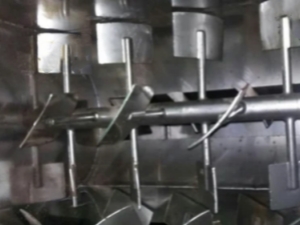
Paddle
A paddle is a common type of blade, usually in the shape of a paddle, used for stirring and mixing feed ingredients. It can push feed ingredients to the mixing area to achieve uniform mixing and ensure even distribution of various ingredients in the feed.

Spiral blades
The spiral blades are in a spiral shape and can effectively propel and mix feed ingredients. It can generate strong shearing and propulsion forces, allowing the feed ingredients to rotate and move quickly in the mixing chamber to achieve better mixing effects.

Blade
Blades are usually used for cutting and mixing feed ingredients and have strong cutting and crushing capabilities. It is able to cut larger feed particles into smaller particles, making them easier to mix and digest.

Mixing blade
The mixing blade is used to stir and mix feed ingredients, and can evenly mix particles of different ingredients. It can push the feed ingredients to the mixing area and mix them thoroughly through the stirring motion to ensure the uniformity of the feed.
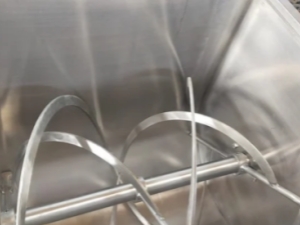
Curved blades
Curved blades are curved or twisted in shape, which can effectively push feed ingredients to the mixing area to achieve uniform mixing. It can generate large stirring force and shearing force to promote the mixing and uniformity of feed ingredients.
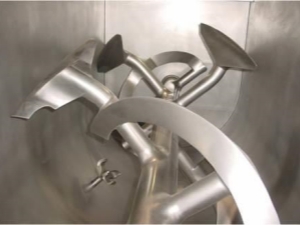
V-shaped blade
The shape of the V-shaped blade is similar to the letter "V", which can provide a larger mixing area and promote the mixing and uniformity of feed ingredients. It can push feed ingredients to the mixing area and mix them thoroughly through stirring motion.
The working principle of single shaft horizontal mixer is as follows:
Material input: Put the materials to be mixed into the mixing chamber of the mixer.
Agitator rotation: Start the mixer so that the shaft and agitator begin to rotate. Agitators usually have a blade or blade structure that can effectively stir and mix materials.
Material interaction: As the mixer rotates, materials continue to interact and collide with other materials in the mixing chamber. This interaction promotes dispersion, mixing and homogenization of materials.
Mixing effect: Through the interaction between the rotation of the mixer and the materials, the materials gradually achieve a mixing effect. The shape and number of agitators can be designed as needed to ensure that the materials can be fully mixed.
Complete mixing:After a certain mixing time, the material reaches the expected mixing effect, stop the operation of the mixer.
Material discharge: Open the discharge port of the mixer and discharge the mixed materials from the mixing chamber for subsequent processing or use.
Efficient mixing
The single shaft horizontal mixer uses a single rotating shaft to provide powerful mixing capabilities. It can evenly mix liquids, suspended solids or solid particles to ensure that materials are fully mixed and improve production efficiency.
High space utilization
Due to the structural design of the single shaft horizontal mixer, it can effectively utilize limited space. It generally has a smaller footprint than other types of mixing equipment, making it suitable for environments with limited space.
Easy to operate
single shaft horizontal mixer usually adopts a simple and intuitive control system, which is easy to operate and control. Operators can easily set mixing speed, time and other parameters via the control panel or buttons to meet specific mixing requirements.
Wide speed adjustment range
Single shaft horizontal mixers usually have a wide speed adjustment range, and the mixing speed can be adjusted as needed. This makes it suitable for different types of materials and process requirements, providing greater flexibility.
Strong durability
single shaft horizontal mixer is usually made of high-quality materials, with good wear resistance and corrosion resistance. This allows them to maintain stable performance over extended periods of use and have a long service life.
Safe and reliable
single shaft horizontal mixers usually have safe and reliable designs, including safety measures such as anti-spill devices, overload protection and emergency stop buttons. These features reduce the risk of accidents and protect the safety of operators and equipment.
| Compare Projects | Single shaft horizontal mixer | Twin shaft horizontal mixer |
| Structureand working principle | It consists of a horizontal stirring shaft and stirring blades on the shaft. The motor drives the stirring shaft through a reducer. The blades rotate to push the material to make a circular motion in the horizontal direction, and the axial displacement is generated to achieve stirring and mixing. | There are two parallel horizontal stirring shafts, each with stirring blades that rotate in opposite directions. When working, the blades are staggered to make the material cross-flow and shear in the horizontal, axial and between the two shafts. |
| Stirring effect | Suitable for simple material mixing or where uniformity is not a high requirement | The stirring and shearing effects are strong, and the materials flow and mix fully in different directions, with good mixing effect and high uniformity. It can handle sticky, fibrous and materials containing particles of different sizes. |
| Applicable scenarios | It is suitable for occasions with low mixing requirements, such as ordinary feed mixing in small feed factories, ordinary masonry mortar mixing, etc. | Applicable to industries with high requirements for mixing uniformity, such as fine chemical raw material mixing, food ingredient mixing, high-end pet feed mixing, etc. |
| Energy consumption and efficiency | Simple structure, small power demand, the energy consumption for processing the same amount of material is usually lower than that of a double shaft, but the stirring intensity and efficiency are low, and the stirring time is long when processing a large amount of material or requiring a high mixing speed. | Dual-axis drive, large power requirements, relatively high energy consumption, but strong mixing ability, can complete material mixing in a short time, large-scale production and high efficiency requirements in the scene has obvious advantages |
| Model | LHY-0.25 | LHY-0.5 | LHY-1 | LHY-1.5 | LHY-2 | LHY-3 | LHY-4 | LHY-6 | LHY-8 | LHY-10 |
| One-time mixing (kg) | 100-150 | 200-300 | 400-600 | 600-900 | 800-1000 | 1200-1800 | 1600-2400 | 2400-3600 | 3200-4800 | 4000-6000 |
| Mixing time (min) | 8-20 | 8-20 | 8-20 | 8-20 | 8-20 | 8-20 | 8-20 | 8-20 | 8-20 | 8-20 |
| Mixing speed (r/min) | 60 | 55 | 45 | 40 | 35 | 25 | 25 | 20 | 15 | 15 |
| Motor power (kw) | 3-5.5 | 4-11 | 7.5-15 | 11-18.5 | 15-22 | 18.5-30 | 22-37 | 37-55 | 37-55 | 45-75 |
| Weight (kg) | 500 | 900 | 1800 | 2500 | 3200 | 4100 | 5100 | 6300 | 7500 |
Single shaft horizontal mixer and single shaft vertical mixer are common mixing equipment. The main differences between them are in structure, working mode and characteristics. The following is a detailed introduction to their differences:
| Types | single shaft horizontal mixer | single shaft vertical mixer |
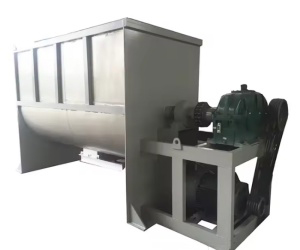 |
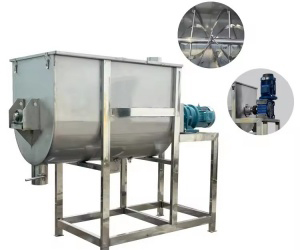 |
|
| Structure | The mixing barrel is placed horizontally, the axis is horizontal, and the mixing frame extends in the horizontal direction. | The mixing barrel is placed vertically, the axis is vertical, and the mixing frame extends in the vertical direction. |
| Working mode | The mixing barrel rotates in the horizontal direction, and the mixing barrel is usually equipped with stirring blades or spiral blades, and mixing is achieved by rotation. | The mixing barrel is usually equipped with stirring blades or spiral blades, and mixing is achieved by vertical rotation of the axis. |
| Features | The mixing effect is uniform, suitable for mixing materials in various forms, relatively simple to operate, and easy to clean. | The mixing effect is uniform, can handle a large amount of materials, and is suitable for mixing materials such as powders and particles. |
Mixer material selection
Usually stainless steel or carbon steel is used, which is corrosion-resistant and wear-resistant, ensuring the durability and hygiene of the mixer.
Seal options
Offering a variety of seal options for the main shaft penetration through the end plates. The selection of seals that are properly suited for the mixing application is important in order to minimize leakage and reduce premature shaft wear.
Discharge location selection
The mixer discharge location is generally dictated by the installation requirements for the mixer and the type and location of the equipment the mixer will discharge into.The most common discharge locations are bottom end (preferred) and bottom center.
Liquid addition options
For processes that require the addition of liquids, it can provide liquid manifolds and/or spray nozzles. Manifold/spray nozzle locations will be determined for optimum performance, directing the liquid(s) onto the material being mixed with minimum spray on exposed mixer components.
Mixer-cover selection
Mixer covers are often a complex part of a mixer design. Mixer covers not only provide protection for moving parts, also provide a means of controlling/controlling dust during the mixing process and provide access for inspection and cleaning. It can be customized based on customer needs.
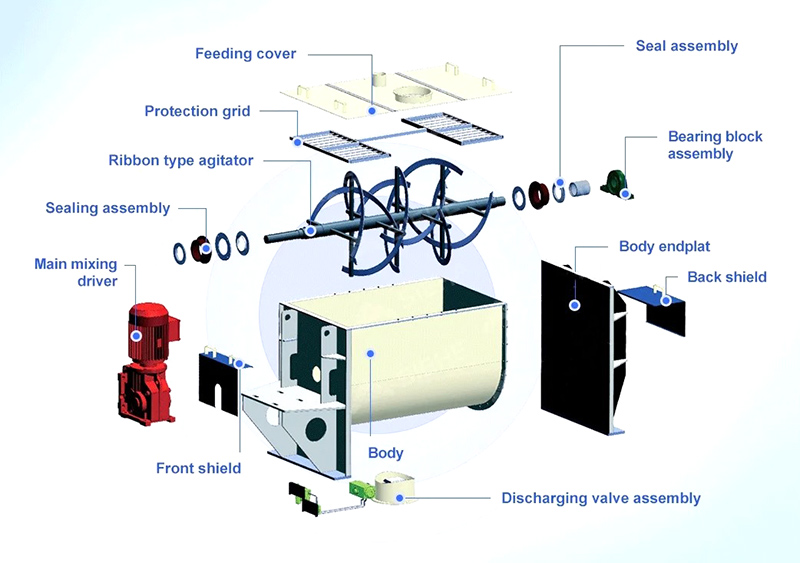
Main structure
The main structure is the supporting frame of the single-shaft horizontal mixer, usually made of solid metal materials, such as steel or cast iron. It provides stability and strength to the entire device.
Stirring paddle or mixer
The stirring paddle is the core component of a single shaft horizontal mixer and is responsible for mixing the materials. Stirring paddles are usually made of metal or wear-resistant materials and have specific shapes and designs to achieve effective mixing results.
Motor
The motor is the key component that provides power and drives the stirring paddle to rotate. Electric motors are usually used as the power source, and their power depends on the needs. The motor is usually connected to the stirring paddle through a shaft to transmit rotational power.
Transmission system
The transmission system transmits the rotational power of the motor to the stirring paddle. It usually includes components such as transmission belts, gears or chain drives to ensure effective energy transfer and stable rotation of the mixing paddle.
Control system
The control system is used to control the operating parameters of the mixer, such as mixing speed, time and other set values. It usually includes components such as control panels, buttons, switches and sensors, which operators can set and monitor through the control system.
Mixing container
A mixing container is a container for placing materials to be mixed, usually located above the main structure. It can be a metal can, glass bottle or plastic bucket with sealing properties to ensure that materials do not spill or leak.
Supports and fixtures
Single-shaft horizontal mixers usually have supports and fixtures to maintain the stability and safety of the equipment. This includes components such as stands, casters, bolts, and mounts to hold the mixer in place.

MIXING TIME AND DISCHARGE TIME
Depending on the type of material, the mixing time is very fast and even when the mixer is not at full load, the mixing time does not slow down due to the special design of the blades.
Mixing time: 8-20 minutes.
Discharge time: The discharge time of Single shaft horizontal mixer is about 10-15 seconds. The mixing plant can work up to 12 batches per hour and is fully automated.
OPTIMAL CLEANING
Total discharge of the product is guaranteed by doors along the entire length of the machine. The materials are mixed evenly and the mixing rate reaches 100%.
MIXING CAPACITY
The particular design of the paddles and ribbons enables our horizontal paddle mixer to consistently achieve a high standard of homogeneity of the mixture. A mixing ratio of 1:100,000, coefficient of variation (CV) <3%, mixing speed is 15-60r/min.
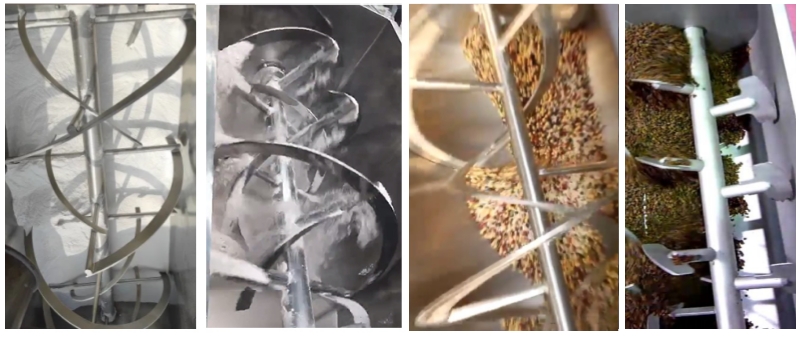
A pharmaceutical company needs to mix different types of dry powder pharmaceutical ingredients to prepare high-quality pharmaceutical formulations. To meet this need, they chose a single-shaft horizontal mixer. This blender has powerful mixing ability to evenly mix various powdered pharmaceutical ingredients, ensuring the consistency and uniformity of pharmaceutical formulas. The mixer has a wide speed range and can be adjusted according to the characteristics of different pharmaceutical ingredients to achieve the best mixing effect.
We are a professional manufacturer of single-shaft horizontal mixers, committed to providing customers with efficient and reliable mixing equipment. The products are made of high-quality materials, with simple structure and stable operation. They are suitable for mixing granular, powdery and slightly viscous materials. We offer a variety of models and capacities, and the price is generally between $1,099.00-$1,999.00 to meet the needs of different customers. Welcome to consult and customize, and provide you with quality service!
Address:China,Yanjin county forest park gate to the west 1000 meters north road.